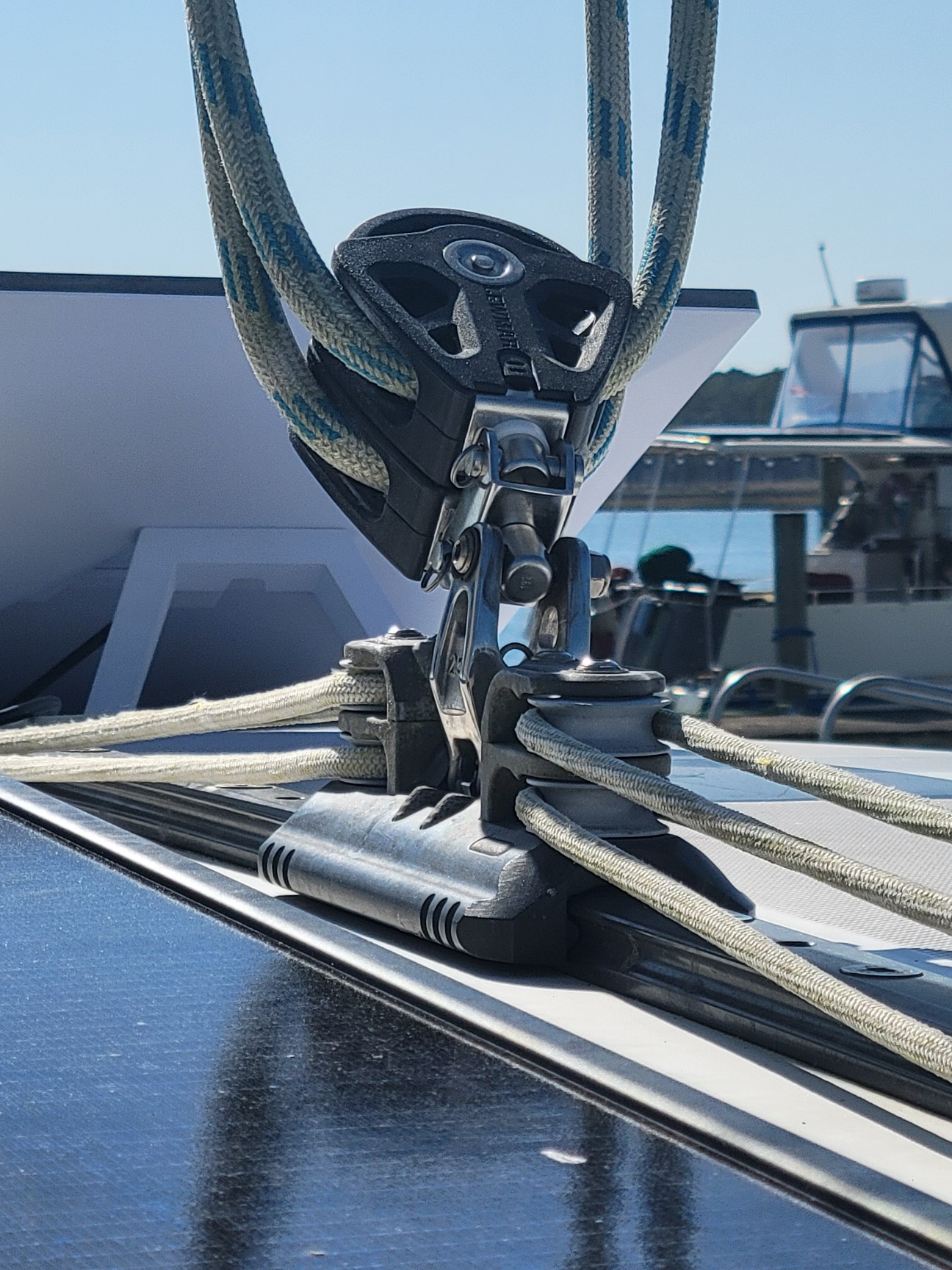Quick Real Time Update
As I write this, we’re sitting at anchor in Lake Worth, at the northern end of West Palm Beach, FL. We arrived here Fri am (02/14) after 3 days off the dock. We actually did three days at sea / two nights in a row of overnight sailing motoring, just Terri and I, from Jacksonville to here. That’s a whole other blog.
We’re now waiting for an appropriate “weather window” to go across to the Bahamas. It’s a straight (ish) shot east from here – no more hopping south down the coast. In order to reach the Bahamas, one needs to cross the Gulf Stream, which can be quite hairy if the wind and waves are in the wrong direction. We hope to cross, later this week – Thu or Fri.
Getting Luthien Ready for Off-Grid
In order to get “here”, in the temporal and metaphysical sense, we have completed all but two of our big upgrades / fixes / replacements to do list and are ready to spend the next few months (partially?) off-grid. I thought I’d share what all work we had done. BUT to keep it fun, instead of talking amp-hours and BTUs, I thought I’d describe it in terms of “what the upgrade allows us to do”.
Old School Cruisers Were Hard Core
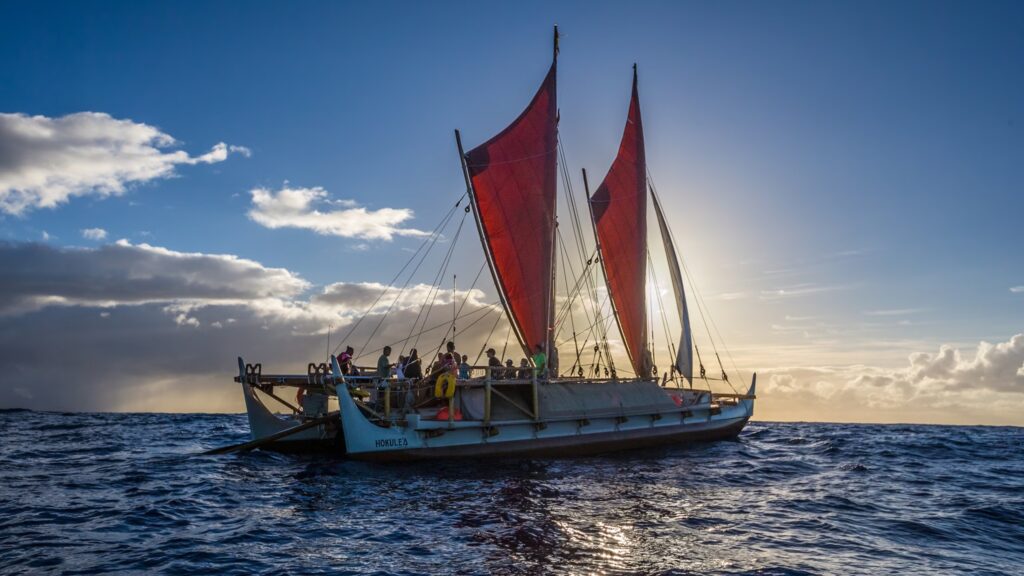
I wanted to write a little preamble about how I am self aware that a lot of the stuff I am about to describe, are very much modern conveniences. We wanted to make Luthien as comfortable as a land based house as much as possible.
I am humbled thinking about old school cruisers. The instructor for a course we took in summer 2023 was a fellow named John Neal. John crossed the Pacific Ocean from east to west and hung out in the South Pacific for several years in a 27’ monohull sailboat in the MID SEVENTIES.
A 27’ monohull probably has 1/10th the living and storage space that Luthien has. No GPS, no AIS, no PredictWind, no solar, no lithium batteries, no StarLink. And DEFINITELY no ice maker. As my own off-grid travels are imminent, I am just now beginning to appreciate how hard core that was.
So, I acknowledge that I am kind of soft in writing this. I definitely wouldn’t be doing this on a 27’ boat in the mid seventies.
With that, here’s what we’ve done:
(this might be long and boring for non boat nerds – read further at your peril)
Major Electrical System Upgrade
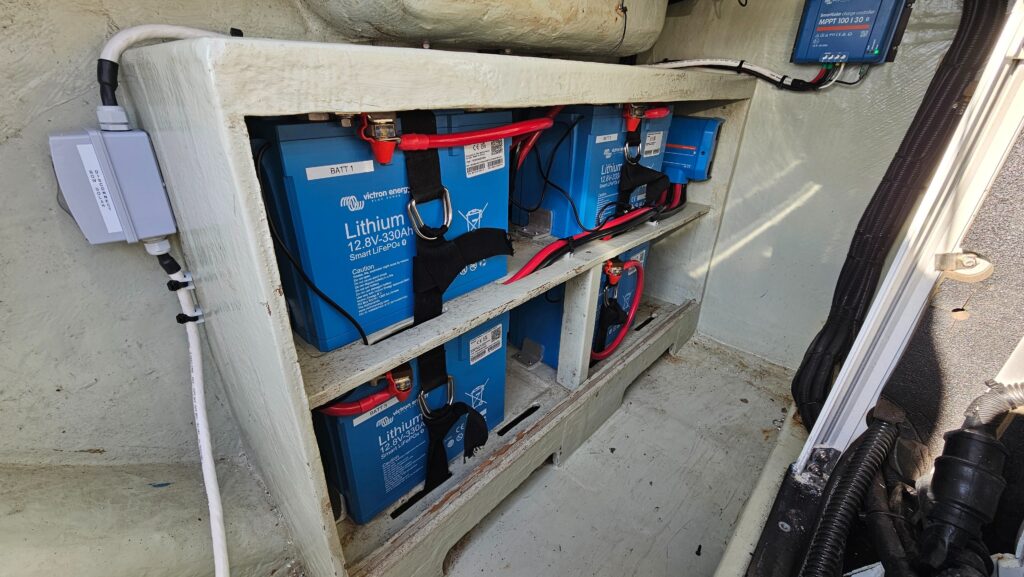
What Was Done
We’ve put in a big new Lithium-Iron-Phosphate (“LFP”, which catches on fire a lot less than regular Lithium-Ion) battery bank, and both a 120V inverter/charger for US power and a 230V inverter/charger for Euro power.
What This Allows Us To Do
The old batteries were shot anyways, and did not even last half way through the night when we were at anchor. So they needed to be replaced regardless. The new batteries basically give us a ton of extra usable power storage. The new batteries are doing awesome and allow us to last ~ 2 days without having to worry about power or fire up the generator.
I will nerd out here just a little bit. The leap in battery technology in the last 10 or so years is truly amazing. Compared with the old “AGM” type batteries we replaced, the new LFP batteries are half of the physical size, weigh half as much (250 lbs vs 500 lbs for 4 batteries), have 3x the useable charge (1200 Ah vs 400 Ah), and have a 3x longer lifetime (10 years vs 3 – 5 years).
Luthien was built in South Africa and her original power system was 230V Euro power. A subsequent owner added 120V US power, approximately 2020. However, some of her appliances, like the water heaters, ice maker, washing machine, are still 230V. So this new 230V inverter allows us to make hot water and ice without running the generator.
Windlass Repaired – Twice
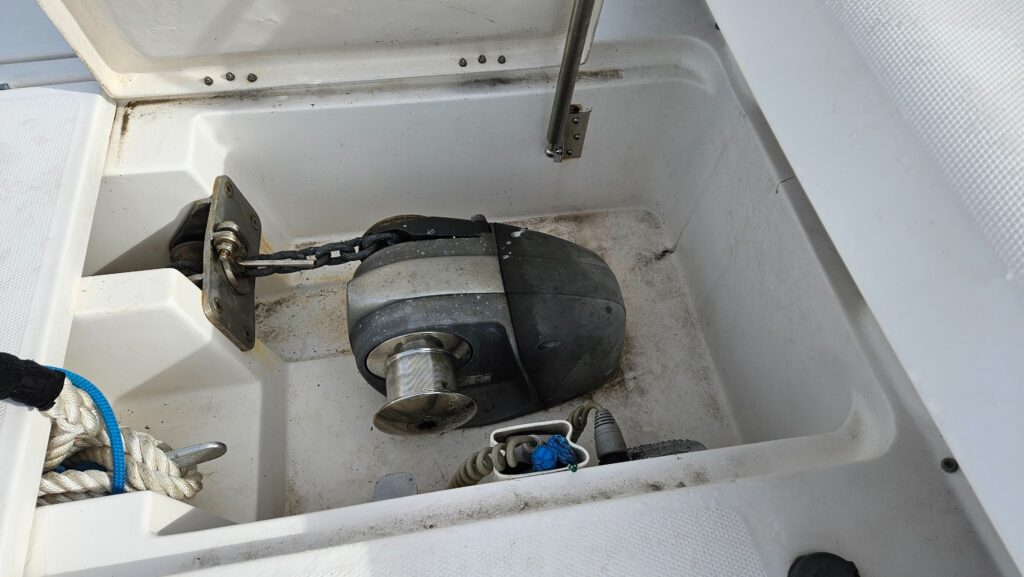
What Was Done
I’ve mentioned in previous blogs that our windlass (the thing that pulls up the anchor) failed on us while on the way down the eastern seaboard, which (among other reasons) obliged us to stay at marinas the whole way down. We put a bandaid on that in Charleston, SC, and used the anchor a few times since then. However, it failed AGAIN on the way down from Jacksonville. UGGGH !
Fortunately, that first time it failed, I ordered a spare electric motor for the windlass and had that shipped to the boat in Charleston. So I had a spare on hand when it failed this latest time. This time, we did not bandaid. I replaced the entire electric motor, just yesterday, and now the anchor is working smoothly.
What This Allows Us To Do
Anchoring is so great if you have the power and the water to do so. (And your windlass works, I suppose). Marinas get progressively more expensive as you head south down the coast, and here in the Palm Beach area, marinas are $200 / night (!) for a boat of Luthien’s size. If they even have space, which they usually don’t.
Anchoring, however, is free. And you can anchor just about anywhere you like. If you can make and store your own power ( solar and/or generator + batteries), you can stay at anchor as long as water and food last. If you can make your own water as well, you can stay at anchor as long as your food lasts.
We are at anchor right now in Lake Worth, thus saving $200 / day by NOT being at a marina. We’re hoping to anchor, 95%+ of the time we’re over in Bahamas.
Owner’s Hull Air Conditioning Replaced
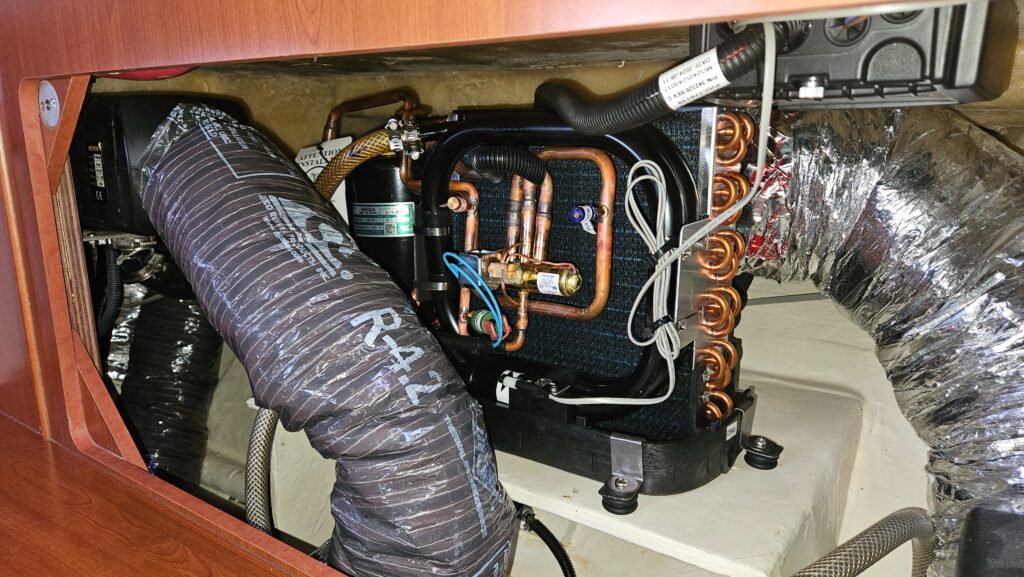
What Was Done
When we first launched Luthien in October, we found out that just turning on the breaker for the starboard hull air conditioner, without actually running the air conditioning, tripped the master breaker for the ENTIRE BOAT. Yikes.
We weren’t overly worried about that at the time since it was October / November and we didn’t really need the air conditioning. However, we’re now looking at cruising southern Bahamas through April – May, so it might be nice to cool our side of the boat down in the evenings. (The guest side air conditioning, works fine).
We finally found a guy here in Florida who was able to take a look at the air conditioner. Apparently this air conditioner was original equipment on the boat – 14 years old – and basically just died of old age. So we had to replace the entire air conditioning unit.
What this allows us to do
Run air conditioning in our hull when the generator is running or we’re on shore power.
We also figured out that the air conditioners have a HEAT PUMP (aka “reverse cycle”) mode.. We had a diesel heater on board, but it is noisy, puts out limited heat, and uses (a little) fuel. The air conditioner, in reverse cycle mode puts out a TON of heat – much more than the diesel heater. It sure would have been nice to have that working during those freezing mornings in the Carolinas!
New Ice Maker
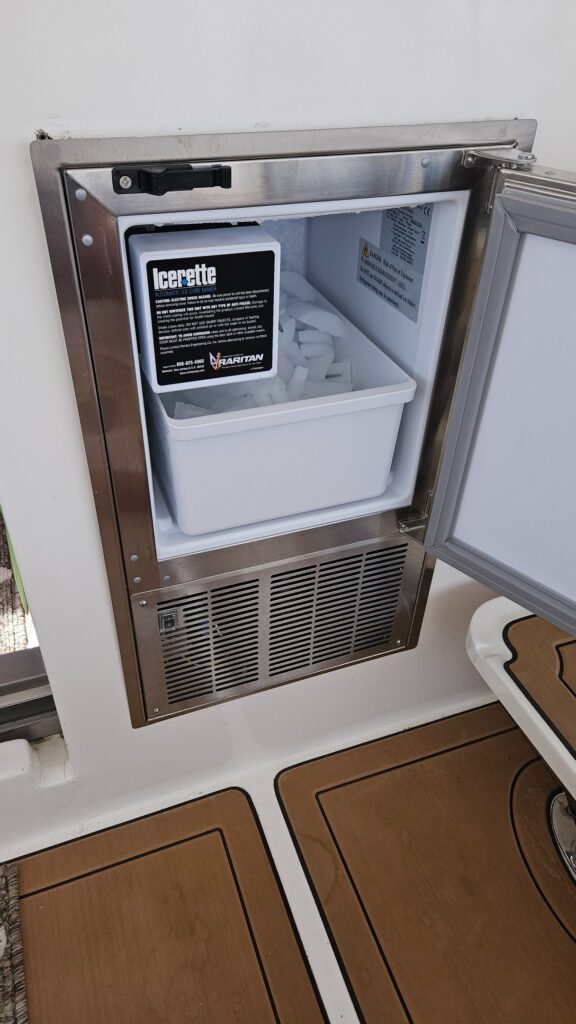
I know, I know.
What was Done
When we bought Luthien, the previous owners told us “the ice maker keeps things cold, but it does not make ice. We use it for a backup freezer.” We figured no big deal, probably just needs the water valve replaced or something relatively easy to repair.
Nope. Come to find out, that was the original equipment ice maker – 14 years old. After a couple days of troubleshooting, we determined there were at least two major repairs needed to get it to make ice and decided to just buy a replacement.
What this allows us to do
I mean drinks, obviously. But also, we actually just use the ice to keep our drinking water cold in our water bottles. We don’t have a cold water dispenser in our refrigerator like at home, and there’s no room in the fridge for a water jug. Our water tanks are uninsulated. So “room temperature” here in FL means 80F. Gross.
Remaining To-Dos
We still have 2 more repairs I need to get done to be truly off grid. Neither of these are “major” in terms of labor (probably < 1 day each). Actually forget I said that. But they are major in terms of allowing us to stay off grid. I was hoping to get these done at the marina in Jacksonville, but time and tide, as the saying goes.
Generator
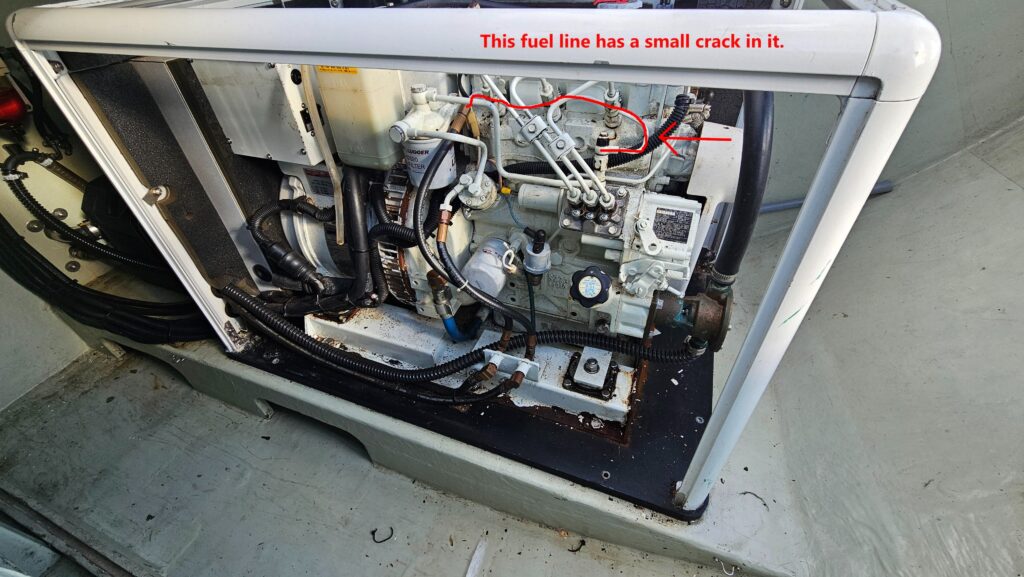
What Needs to be Done
This generator has been giving us no end of trouble. I thought I had it fixed just prior to Christmas, only to find it wouldn’t start again once we got back to Luthien in January. I could write a “Crime and Punishment” length blog about all the things we tried with this generator.
Most recently, we found out we needed a part that was totally sold out in North America and had a 3 month backorder wait time. Ughh !!
Believe it or not, Facebook came to the rescue on this one. There is a “Leopard 46 Owners” group on there, which we are members of. People use that for finding good marinas / anchorages, upgrade or remodel ideas, and finding spare parts . We were able to find a dude in South Africa ! who had the part we needed and he shipped it to us in Jacksonville via DHL Express !
I have that part in hand now and just need to get it installed.
What This Will Allow Us to Do
We don’t have much solar on the boat, yet, so we need the generator to be working to recharge the batteries when we are off-grid. We have alternators on the engines of course, but they produce a tiny amount of power compared to the capacity of the batteries and use a lot of fuel to do so. I did a little napkin math and calculated we would need to run both engines for 20 hours (!) to recharge the batteries. That’s about $100 worth of diesel.
Additionally, the air conditioners / heat pumps use a ton of power when they are on, so they are wired up to only operate when the generator is running or when we are on shore power. So, e.g., if we are in some place particularly hot, we might run the generator for an hour or two in the evening to cool the boat down for sleeping.
Watermaker
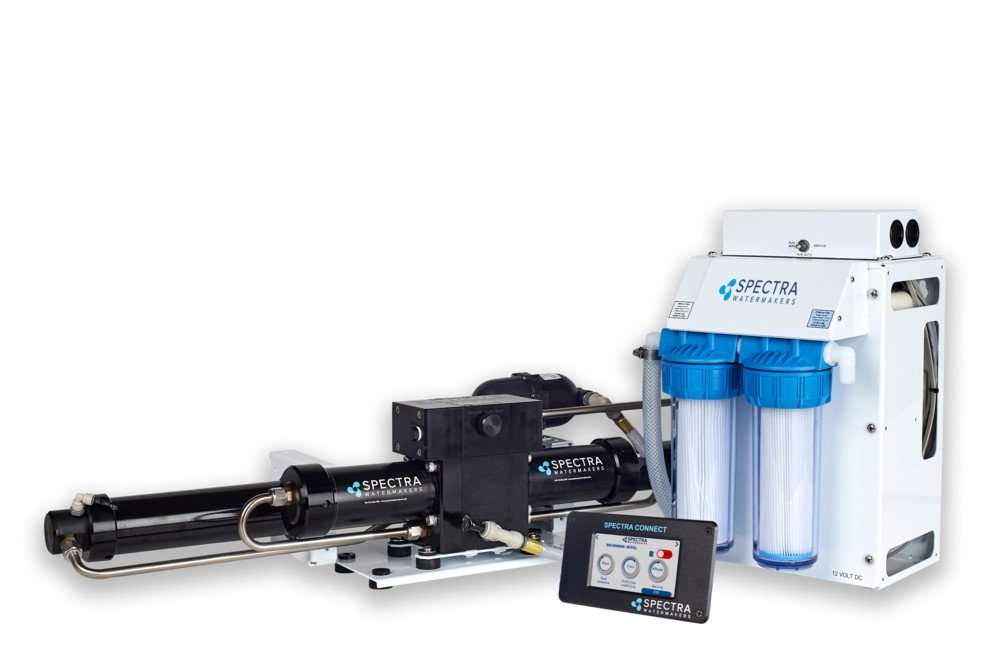
What Needs To Be Done
So there is a watermaker on board. And we are grateful that came as part of the sale. That is an expensive bit of kit – a new watermaker of our make and model is around $16,000. ( !! ). The watermaker had been removed from the boat, rebuilt, and re installed on the boat prior to the sale. However, come to find out, none of the plumbing or electrical was hooked back up when it was re-installed.
I need to get that plumbing and electrical hooked back up. However, some fittings are also missing, so I need to chase down parts as well.
What This Will Allow Us to Do
The watermaker allows us to stay at anchor / off grid much longer, constrained only by the amount of food we’re carrying.
Somewhat crazily, I think, this device allows us to make fresh drinking water out of sea water. To nearly the purity of distilled water, with the exception of some trace minerals. I know submarines can do this, but it seems wild for small private sailboats to have these on board.
We’ve got about 3 months of provisions on board, but “only” two hundred gallons of water in tanks, which lasts us about two weeks without really trying too hard to conserve water. That is still a decent amount of water.
But having a watermaker gives us nearly unlimited water. Limited only by the amount of power we can make either either via solar or generator. Watermakers are both power hungry and noisy, so you don’t want to run them all the time. Typically cruisers will run the watermaker for an hour or so per day just to top up the tanks.
Epilogue
Welp, that’s enough on boat equipment for now (and probably enough for quite a while). Next blog will hopefully be coming to you from the Bahamas !



